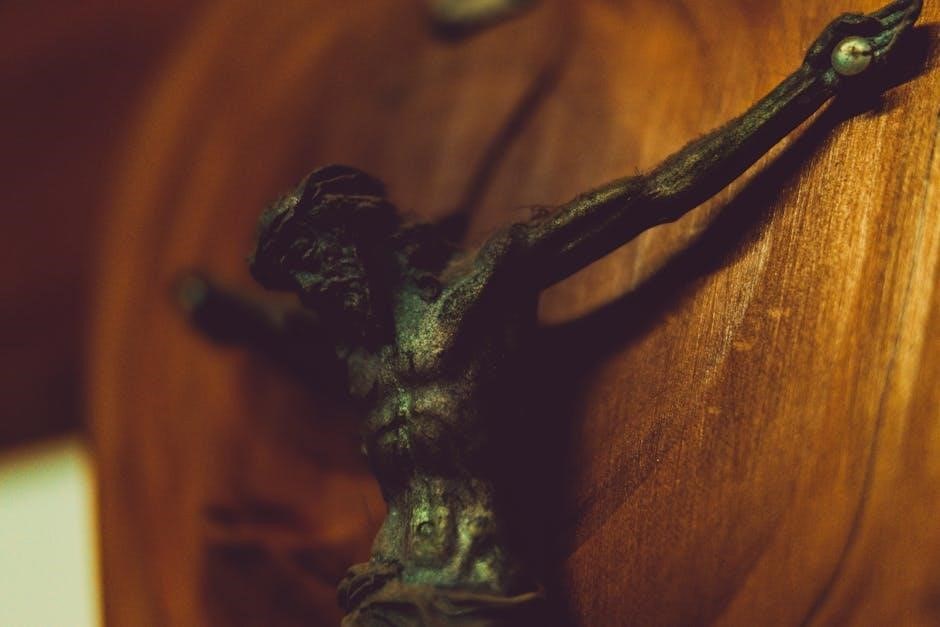William Golding’s timeless novel explores human nature, society, and morality through a group of stranded boys. Its enduring themes resonate globally, making it a literary classic.
1.1 Background and Context of the Novel
William Golding’s Lord of the Flies, published in 1954, is a thought-provoking novel that explores human nature and societal structures. Set during an unspecified war, the story follows a group of boys stranded on a deserted island. The novel reflects Golding’s experiences in World War II and his pessimistic view of human inherent savagery. The post-war era’s focus on human behavior and morality influenced its creation. Today, the novel remains widely studied, with PDF versions and adaptations like Peter Brook’s 1963 film, which was bravely filmed with amateur actors on a Puerto Rican island, showcasing its enduring relevance.
1.2 William Golding and His Literary Style
William Golding’s literary style in Lord of the Flies is marked by simplicity, depth, and symbolism. His concise prose reflects his naval background and wartime experiences, which shaped his pessimistic view of human nature. Golding uses the island as a microcosm of society, employing vivid imagery to explore themes like savagery and morality. His writing is both evocative and unsettling, creating a haunting atmosphere that lingers with readers. This style has made the novel a timeless classic, widely studied in PDF versions and adaptations, ensuring its enduring impact on literature and education.
Plot Summary of “Lord of the Flies”
A group of boys, stranded on an island, attempt to create a civilized society but descend into chaos, revealing the darker aspects of human nature.
2.1 The Stranded Boys and Their Initial Harmony
The novel begins with a group of British boys stranded on a remote island after a plane crash. Initially, they exhibit optimism and unity, electing Ralph as their leader. The conch shell, a symbol of democracy, is used to maintain order during meetings. The boys’ early cooperation reflects their innocence and desire to recreate a civilized society. They focus on building shelters and maintaining a signal fire, showcasing their initial harmony and shared goals. This period of unity sets the stage for the eventual conflicts that arise as their true nature unfolds.
2.2 The Rise of Conflict and Power Struggles
Tensions emerge as Jack Merridew’s desire for power clashes with Ralph’s leadership. Jack’s obsession with hunting symbolizes his growing savagery, while Ralph focuses on building shelters and maintaining order. The group’s unity begins to fracture as Jack challenges Ralph’s authority, leading to divisions among the boys. The conch shell’s influence wanes, and meetings become chaotic. This power struggle highlights the boys’ primal instincts and the erosion of their initial harmony, setting the stage for further conflict and the descent into savagery.
2.3 The Descent into Chaos and Savagery
The boys’ behavior deteriorates as fear and savagery dominate. Jack’s tribe hunts and kills pigs, painting their faces to embrace their primal instincts. Ralph’s group struggles to maintain order, but their efforts are futile. The “beast” becomes a shared fear, leading to paranoia and violence. Simon’s tragic death at the hands of his peers marks the peak of chaos. The island, once a symbol of hope, becomes a place of terror and destruction, reflecting the boys’ complete abandonment of civilized norms.
2.4 The Climactic Rescue and Its Implications
The novel reaches its climax when a naval officer rescues the boys, interrupting their savage state. The rescue symbolizes a return to civilization, contrasting sharply with their descent into chaos. However, the boys’ experiences leave a lasting impact, revealing the thin line between order and savagery. The officer’s arrival underscores the loss of innocence and the harsh realities of human nature. The rescue serves as a poignant reminder of society’s influence on behavior, highlighting the novel’s exploration of humanity’s duality.

Major Themes in “Lord of the Flies”
The novel explores human nature, society, and morality, examining the conflict between civilization and savagery, the effects of fear, and the corrupting influence of power.
3.1 Civilization vs. Savagery
The struggle between civilization and savagery is central to Lord of the Flies. The boys’ initial adherence to moral codes gradually erodes, revealing their primal instincts. Ralph’s leadership represents order and democracy, while Jack’s desire for power and control symbolizes the descent into chaos. The conch shell, a symbol of civility, loses its authority as fear and violence dominate. This theme highlights how quickly societal norms can disintegrate without external constraints, exposing humanity’s inherent capacity for savagery.
3.2 The Nature of Humanity
Lord of the Flies explores the inherent duality of human nature, revealing how quickly societal norms can crumble. The boys’ descent from civility to savagery illustrates humanity’s capacity for both good and evil. Golding suggests that humans are inherently flawed, with a natural inclination toward violence and power struggles. The novel serves as a commentary on the darkness within human hearts, emphasizing that morality is a learned behavior, not an innate trait. This theme underscores the fragility of human decency when external constraints are removed.
3.3 Power and Leadership
The novel examines how power dynamics shape human behavior, particularly through Ralph and Jack’s contrasting leadership styles. Ralph represents democratic ideals, emphasizing collective decision-making and order, while Jack embodies authoritarianism, prioritizing dominance and control. The conch shell, a symbol of equality, gradually loses its power, reflecting the erosion of democratic values. Golding illustrates how the pursuit of power corrupts even the well-intentioned, leading to a shift from cooperation to coercion. This theme highlights the fragility of leadership and the dangers of unchecked ambition in the absence of societal constraints.
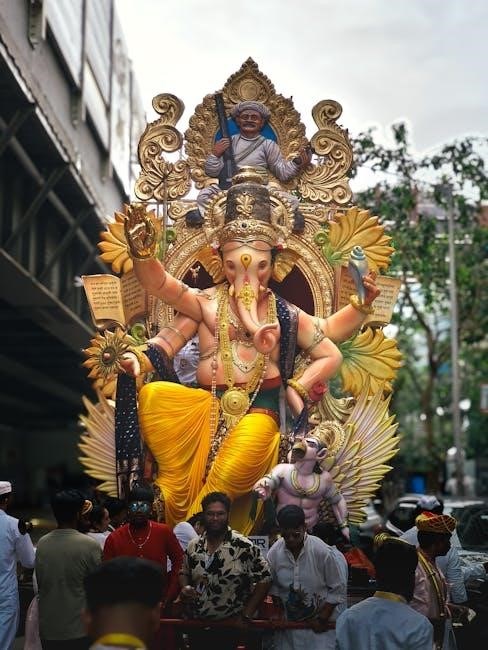
3.4 Fear and Its Consequences
Fear plays a pivotal role in the novel, driving the boys’ actions and decisions. The mysterious “beast” becomes a shared fear, fostering paranoia and mistrust. This fear escalates tensions, leading to irrational behavior and violence, such as the brutal killing of Simon. The boys’ fear of the unknown also symbolizes deeper human anxieties about the uncontrollable forces of nature and the darkness within themselves. Golding illustrates how fear can dismantle rationality, leading to chaos and the breakdown of civility, ultimately revealing the primal instincts lurking beneath the surface of humanity.
3.5 Morality and Ethics
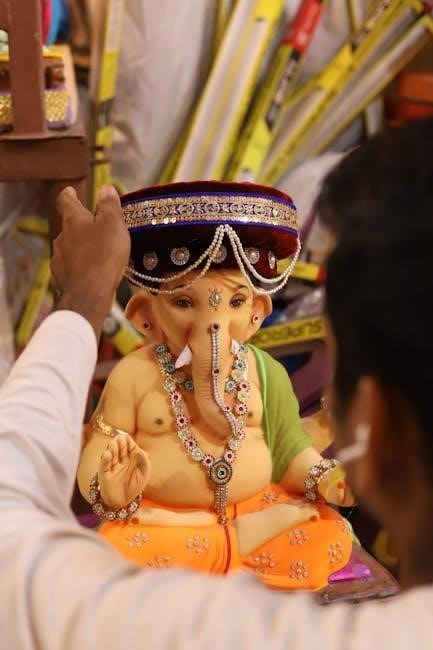
Morality and ethics are central themes in Lord of the Flies, as the boys’ behavior evolves from civilized norms to primal instincts. The conch shell, a symbol of democracy, initially represents their moral code, but its influence wanes as fear and power dominate. Characters like Ralph and Piggy embody ethical reasoning, while Jack’s descent into savagery reflects a rejection of morality. The novel highlights how the absence of societal constraints leads to moral decay, ultimately revealing the darkness inherent in human nature and the necessity of ethical frameworks to maintain order and humanity.
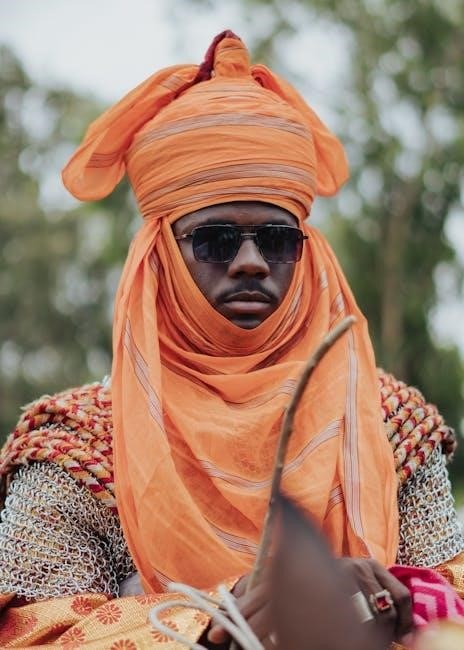
Key Characters in the Novel
Ralph, Jack, Piggy, Simon, and Roger are central figures, each representing distinct aspects of human nature, leadership, and morality, shaping the novel’s dramatic progression.
4.1 Ralph: The Symbol of Order
Ralph, the protagonist, embodies order and civility, striving to maintain democracy and structure among the stranded boys. Elected as leader, he uses the conch shell to enforce rules, symbolizing fairness and equality. His focus on building shelters and maintaining a signal fire reflects his practicality and responsibility. However, as the novel progresses, Ralph’s leadership is challenged by Jack’s desire for power, leading to internal conflict. Ralph’s eventual realization of humanity’s true nature highlights his growth and the novel’s exploration of societal norms and individual morality.
4.2 Jack: The Embodiment of Savagery
Jack Merridew begins as a choir leader but evolves into a symbol of savagery, driven by a desire for power and control. His obsession with hunting and his eventual rejection of Ralph’s leadership highlight his primal instincts. Jack’s formation of a rival tribe and his embrace of violent rituals underscore his descent into chaos. His actions, such as the brutal killing of the pig and the death of Simon, reveal his complete abandonment of moral constraints. Jack’s character serves as a stark contrast to Ralph’s civility, embodying the darker aspects of human nature explored in the novel.
4.3 Piggy: The Voice of Reason
Piggy, the intelligent and rational member of the group, represents logic and wisdom. Despite his physical limitations and asthma, he provides crucial ideas, such as using the conch shell for order. His loyalty to Ralph and commitment to civility make him a moral anchor. Piggy’s glasses, a symbol of clarity and knowledge, are pivotal in starting fires and signaling for rescue. His tragic death, at the hands of Roger, signifies the loss of reason and the descent into savagery, highlighting the novel’s exploration of humanity’s fragile grip on civilization.
4.4 Simon: The Innocent Visionary
Simon, a quiet and introspective boy, embodies innocence and wisdom. He discovers the truth about the “beast,” revealing it as a dead pilot, symbolizing the true nature of fear. His encounter with the “Lord of the Flies” in the jungle highlights his visionary understanding of humanity’s inherent darkness. Despite his epilepsy and shy demeanor, Simon’s kindness and empathy set him apart. His tragic death, at the hands of the boys in a frenzied ritual, underscores the loss of innocence and the descent into savagery, making him a poignant symbol of moral clarity and sacrifice.
4.5 Roger: The Enforcer of Chaos
Roger, a quiet yet sadistic boy, evolves into a key enforcer of chaos under Jack’s rule. His enjoyment of inflicting pain and intimidating others, such as Henry, reveals his darker nature. Roger’s actions, like throwing stones near Henry and later tormenting Sam and Eric, showcase his cruelty. His role in Piggy’s death, dropping the boulder that kills him, highlights his complete embrace of savagery. Roger’s character symbolizes the dangers of unchecked aggression and the ease with which individuals can abandon morality in favor of power and control.

Symbolism in “Lord of the Flies”
Golding masterfully uses symbols like the conch, beast, and island to explore themes of order, fear, and societal collapse, enriching the novel’s depth and meaning.
5.1 The Conch Shell: A Symbol of Democracy
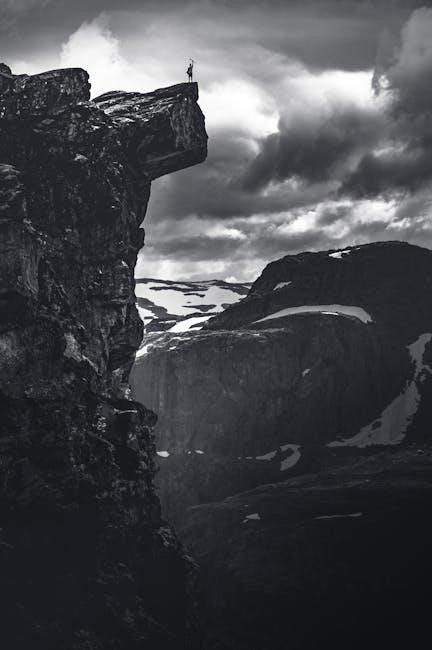
The conch shell serves as a powerful symbol of democracy and order in the novel. Found by Piggy, it is used to call meetings and ensure each boy has a chance to speak, representing equality and civility. As the boys’ behavior deteriorates, the conch’s influence wanes, symbolizing the erosion of democratic values. Its destruction mirrors the collapse of their makeshift society, highlighting the fragility of order without adherence to moral principles. The conch’s significance underscores Golding’s exploration of human nature and governance.
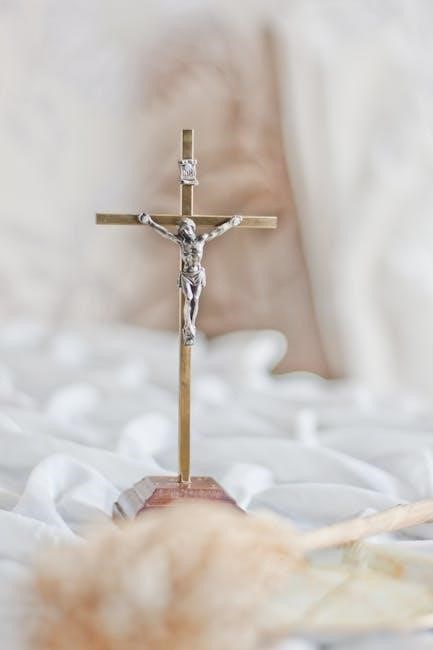
5.2 The Beast: A Representation of Fear
The Beast is a central symbol in “Lord of the Flies,” embodying the boys’ collective fear of the unknown. Initially, it is perceived as a mysterious creature on the island, sparking terror and paranoia. As the novel progresses, the Beast becomes a metaphor for the primal fears within the boys themselves. The legend of the Beast grows, leading to irrational behavior and division among the group. It symbolizes how fear can dominate human actions, driving individuals toward savagery and away from reason. The Beast’s presence underscores Golding’s exploration of humanity’s darker instincts and the fragility of civilized behavior.
5.3 The Island: A Microcosm of Society
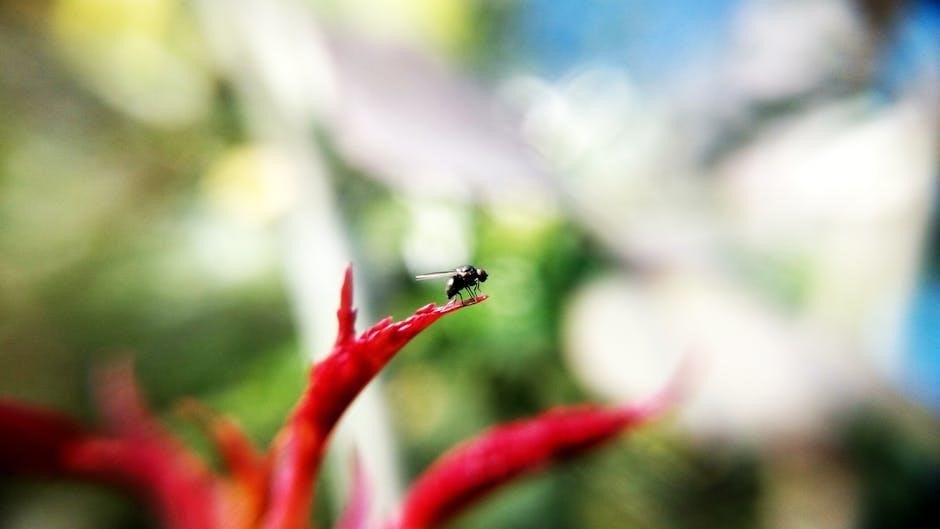
The island in “Lord of the Flies” serves as a microcosm of society, reflecting human behavior, power dynamics, and moral struggles. Isolated from civilization, the boys’ actions mirror societal structures, revealing inherent flaws. The island’s beauty contrasts with the chaos that unfolds, symbolizing how order can deteriorate without governance. Golding uses the island to explore themes of leadership, fear, and morality, creating a scaled-down version of the world where primal instincts and civilized norms clash. This setting allows readers to observe humanity’s true nature in a controlled environment.
5.4 The Lord of the Flies: A Symbol of Evil
The Lord of the Flies, a pig’s head impaled on a stake, symbolizes the inherent evil within humanity. It represents the primal savagery that emerges when civilization fades. This gruesome offering to the “beast” becomes a ritualistic symbol of the boys’ descent into darkness. The flies swarming around it mirror the corruption spreading among the group. This powerful image underscores Golding’s exploration of human nature’s duality, highlighting the evil that exists within and how it manifests when societal constraints are removed.
Literary Analysis and Criticism
William Golding’s Lord of the Flies is acclaimed for its profound exploration of human nature, with critics praising its structured narrative and symbolic depth, sparking enduring debates.
6.1 Golding’s Use of Language and Style
Golding’s prose in Lord of the Flies is both vivid and symbolic, creating a stark contrast between the island’s beauty and the boys’ descent into savagery. His use of descriptive language paints the island as a microcosm of society, while his sparse, direct style emphasizes the raw emotions and primal instincts of the characters. The novel’s third-person perspective allows for a detached yet intimate view of the boys’ actions, heightening the tension and moral complexity. Golding’s language masterfully reflects the themes of civilization, fear, and humanity’s darker impulses.
6.2 The Structure of the Novel
Lord of the Flies is structured to mirror the boys’ descent from order to chaos. The novel is divided into chapters that reflect the progression of their society, starting with hope and cooperation, then unraveling into fear and savagery. Golding uses a chronological narrative, building tension through key events like the hunt for the “beast” and the splitting of the group. The structure emphasizes the gradual erosion of civilization, culminating in the climactic rescue. This deliberate pacing underscores the novel’s themes of human nature and societal collapse.
6.3 Critical Reception and Interpretations
Lord of the Flies has sparked intense debate since its release. Critics praise its exploration of human nature, with some viewing it as a cautionary tale about societal collapse. The novel’s bleak outlook on humanity has led to interpretations ranging from nihilistic to deeply philosophical. Scholars often analyze its themes of power, morality, and fear, while educators highlight its relevance in understanding human behavior. The novel’s enduring popularity lies in its ability to provoke thought about civilization’s fragility and the darkness within us all.
Adaptations of “Lord of the Flies”
Peter Brook’s 1963 film adaptation of Lord of the Flies remains a notable interpretation, shot on a Puerto Rican island with amateur actors, capturing the novel’s eerie essence.
7.1 Film Adaptations: A Comparative Analysis
The 1963 film adaptation by Peter Brook is a seminal interpretation, capturing the novel’s eerie atmosphere through its raw, unpolished style and amateur cast. Shot on a remote Puerto Rican island, it emphasizes the boys’ descent into savagery. In contrast, Harry Hook’s 1990 version offers a more polished take, incorporating modern cinematography and professional actors. Both films stay true to Golding’s themes but differ in tone and execution, with Brook’s version praised for its authenticity and Hook’s for its visual appeal. These adaptations highlight the novel’s enduring cinematic potential.
7.2 Stage Play Adaptations
Nigel Williams’ stage adaptation of Lord of the Flies brings Golding’s gripping narrative to life, capturing the boys’ descent into savagery. The play retains the novel’s core themes, emphasizing the clash between order and chaos. Staging challenges include depicting the island setting and the boys’ primal actions. Performances often leave audiences reflecting on humanity’s darker instincts. The play’s success lies in its ability to mirror the novel’s emotional depth, making it a powerful medium for exploring Golding’s timeless questions about civilization and human nature.
7.3 Other Media Inspired by the Novel

Beyond films and plays, Lord of the Flies has influenced various media, including radio dramas, audiobooks, and even video games. These adaptations creatively reinterpret the novel’s themes, such as the struggle between order and savagery. Radio broadcasts focus on the psychological depth of characters, while audiobooks offer immersive storytelling. Video games explore survival dynamics, mirroring the boys’ experiences. These diverse interpretations highlight the novel’s universal appeal and its ability to transcend traditional storytelling formats, engaging new audiences with its timeless message.
Educational Resources and Study Guides
PDF versions of Lord of the Flies are widely available for educational use, offering convenient access to the text. Study guides and summaries provide in-depth analysis, aiding students in understanding themes, characters, and symbolism. Essay topics and discussion questions encourage critical thinking and exploration of the novel’s deeper meanings, making these resources invaluable for academic study and preparation.
8.1 PDF Versions of the Novel
PDF versions of Lord of the Flies are widely available, offering readers a convenient and accessible format. These digital copies often include features like searchable text, adjustable fonts, and bookmarking. Many educational institutions and online platforms provide PDFs for easy access, making it simpler for students and enthusiasts to engage with the novel. However, it’s important to ensure that the source is authorized to avoid copyright issues. PDFs are particularly useful for annotations and highlighting, enhancing the reading and study experience.
8.2 Study Guides and Summaries
Study guides and summaries for Lord of the Flies are invaluable resources for students and educators. These materials provide detailed analysis, character insights, and thematic breakdowns, helping readers grasp the novel’s complexities. Many guides include chapter-by-chapter summaries, discussion questions, and essay topics, making them ideal for classroom use. They often highlight key symbols, such as the conch shell and the beast, and explore Golding’s exploration of human nature. These resources are designed to enhance understanding and facilitate deeper discussions about the novel’s enduring themes and relevance.
8.3 Essay Topics and Discussion Questions
Essay topics for Lord of the Flies often explore themes like civilization vs. savagery, leadership, and morality. Questions might include: How does Jack’s descent into savagery mirror human nature? What role does fear play in the boys’ actions? How does Ralph’s leadership contrast with Jack’s? Discussion questions encourage analysis of characters like Piggy and Simon, examining their symbolic roles. These prompts help students delve into Golding’s critique of society and the inherent darkness in humanity, fostering critical thinking and deeper understanding of the novel’s timeless themes.
Conclusion
Lord of the Flies remains a profound exploration of human nature, society, and morality. Its timeless themes and haunting lessons continue to resonate, influencing literature and adaptations globally.
9.1 The Enduring Relevance of “Lord of the Flies”
Lord of the Flies remains a timeless exploration of human nature, society, and morality. Its themes of civilization vs. savagery and the inherent darkness in humanity continue to resonate. The novel’s universal appeal lies in its ability to provoke thought about how quickly societal norms can crumble. As a widely studied text, it challenges readers to reflect on their own moral boundaries. Its relevance is further underscored by adaptations, like Peter Brooks’ film, which bring its haunting lessons to new audiences, ensuring its impact endures across generations.
9.2 The Novel’s Impact on Modern Literature
Lord of the Flies has profoundly influenced modern literature, challenging societal views on human nature and civilization. Its exploration of inherent darkness and moral decay inspired countless authors to explore similar themes. The novel’s raw, unflinching style has set a benchmark for dystopian and psychological fiction. Its influence extends beyond literature, with adaptations like Peter Brooks’ film showcasing its universal appeal. As a cornerstone of academic curriculums, it continues to spark critical thinking, ensuring its legacy as a pivotal work in 20th-century literature.
